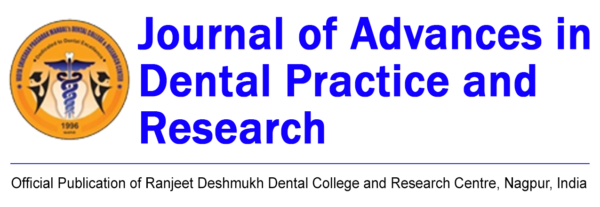Awareness and knowledge among medical undegraduates regarding maxillofacial defects and its rehabilitation
*Corresponding author: Dr. Samidha Pande, Assistant Professor, Department of Prosthodontics, Ranjeet Deshmukh Dental College, Nagpur, Maharashtra, India. samidhashailesh@gmail.com
-
Received: ,
Accepted: ,
How to cite this article: Mishra SJ, Pande S. Awareness and knowledge among medical undegraduates regarding maxillofacial defects and its rehabilitation. J Adv Dental Pract Res. 2024;3:34-9. doi: 10.25259/JADPR_46_2023
Abstract
Objectives
Knowledge, implication, and awareness about maximal disability and recovery among dental and medical students.
Material and Methods
This questionnaire-based survey is designed based on awareness and knowledge among dental and medical undergraduate students. Data were collected through a survey questionnaire with 15 questions that were filled in an online survey link. This study was approved by the Institutional Ethics Committee, VSPM Dental College. Overall 300 participants took part in the survey. The data was collected and statistically analysed.
Results
The study revealed that most of the participants are aware of maxillofacial defects and their prosthetic rehabilitation and also the recent advances in dentistry regarding maxillofacial prosthesis.
Conclusion
Undergraduates have an understanding, point of view, and awareness regarding dentofacial and craniofacial defects and its rehabilitation. The undergraduates are aware about the recent advances that can be used to deliver proper care and advise the patient for the best possible rehabilitation.
Keywords
Prosthetic rehabilitation
Maxillofacial defects
Maxillofacial prosthesis
INTRODUCTION
An Individual’s face has a unique role in social and emotional expression and communication, and above all, it is a reflection of that person as correctly expressed in Saint Jerome’s saying “the face is the mirror of mind.”[1]
Maxillofacial defects are common outcomes seen after a major trauma, congenital deformities, destruction of tissues due to infectious or autoimmune processes, and complications of therapy (e.g., osteoradionecrosis). These defects often need reconstruction for a person to regain his/her lost confidence and identity. For this purpose, reconstructive surgery is considered the primary treatment of choice in such cases, although not all defects are surgically treated and have to be corrected with the help of prosthesis.[2]
The choice of reconstructive procedure depends on several factors such as size, localization of defects, loss of important anatomic structures, and general weakness of the patient.[3]
Maxillofacial restoration is a theme that involves 2 important branches, named as craniomaxillofacial surgery and prosthodontics, that are concerned with utilitarian and ornamental stomatognathic restoration.[4]
Maxillofacial defects lead to psychological suffering as well as a debilitating effect on the patient’s appearance and thus need to be corrected.[5] Among other things, the patient’s abilities are also limited or altered, such as speaking, listening, and ability to see. He or she also suffers mental stress, with looks serving as the main trigger. Thus, correct diagnosis and treatment strategy are very important for the effective rehabilitation of the patient.
Maxillofacial abnormalities must be treated with meticulous diagnosis and collaboration among all treatment providers so the patients who have such defects should be properly channeled to the specialists by their doctors for timely rehabilitation.[6]
The dentists or doctors who are being consulted need to have a fundamental knowledge of maxillofacial surgery faults and the fields of expertise involved in the remedies for them. A scientifically good, supervised undergraduate education in the investigation, therapy options, and fundamental treatment planning is unquestionably a top requirement given the number of and the consequent Economic and health relevance of craniofacial trauma and cancer consultations.[7]
Due to patients’ growing awareness of their physical appearance, dentistry in the 21st century focuses mostly on esthetics and reconstruction, and thus all doctors should be aware of the specialties for properly streamlining the patients in need.[8]
Aim
To evaluate knowledge, attitude, and awareness regarding maxillofacial defects and their prosthetic rehabilitation among dental and medical undergraduate students.
MATERIAL AND METHODS
This study is a questionnaire-based survey which was designed to evaluate the awareness and knowledge among dental and medical undergraduate students.
Data was collected through a survey questionnaire with 15 questions that were filled through an online survey link. This study was approved by the Institutional Ethics Committee of VSPM Dental College, Nagpur. Overall 300 participants took part in a survey. The data were collected and statistically analyzed.
RESULTS
The study concluded that maximum undergraduate students along with interns irrespective of the gender of VSPM Dental College and Research Center and NKP Salve Institute of Medical Science, were aware of maxillofacial defects, though there were some who lacked the knowledge. The results are depicted in Figures 1-14 and Table 1 depicts the type of participants involved in the study and Table 2 represents results of the questionnaire used for the study.
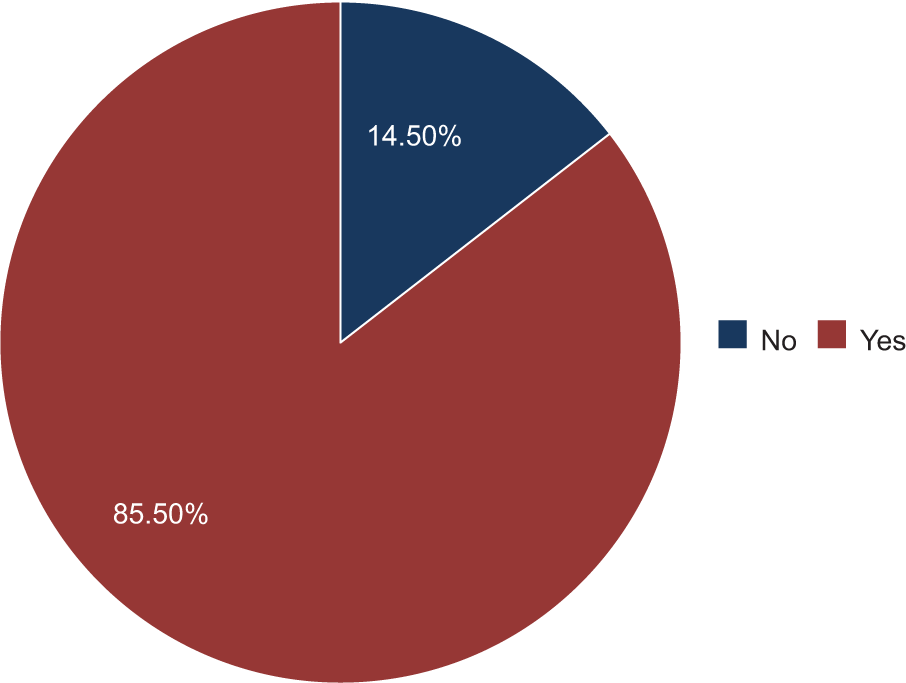
- Do you know about maxillofacial defects?
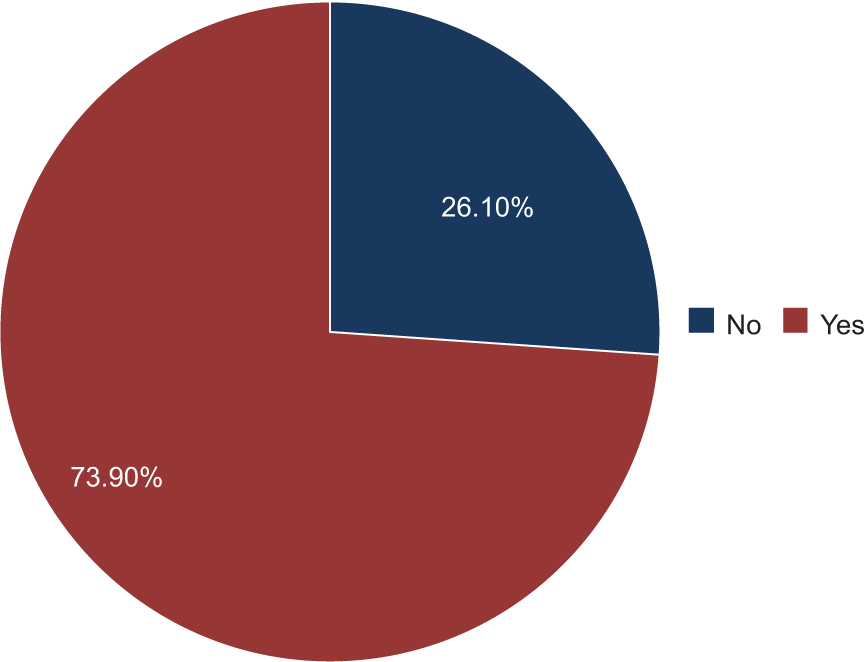
- Have you ever seen a clinical case of maxillofacial defect?
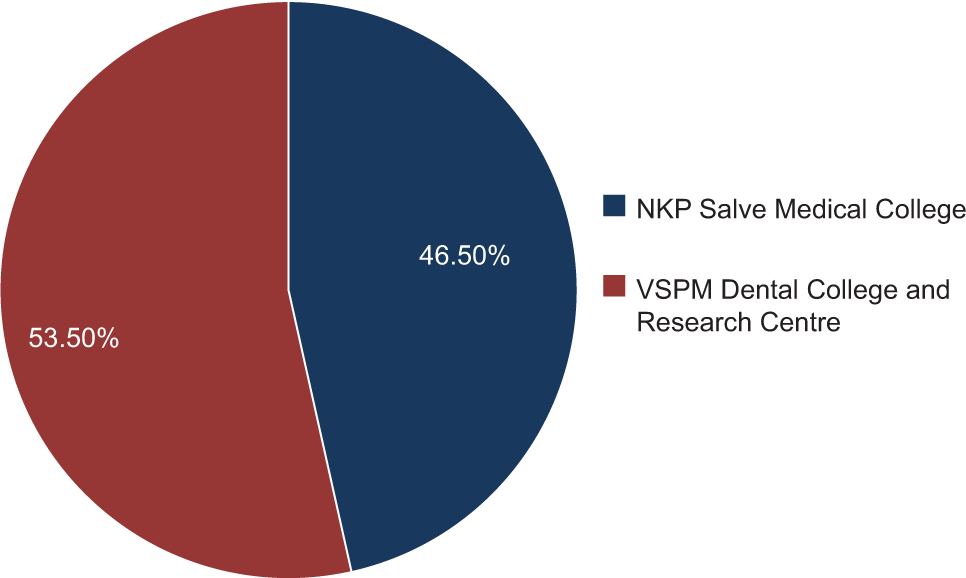
- Name of college.
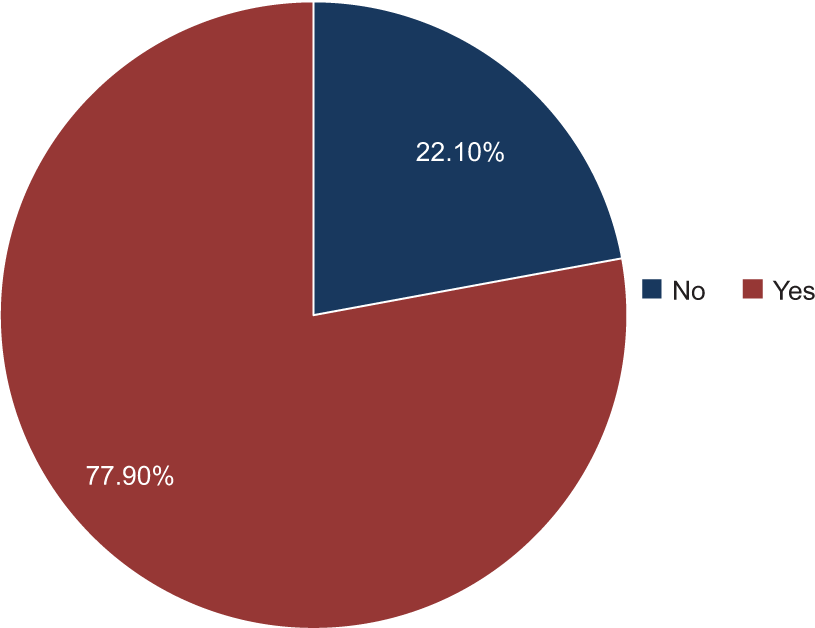
- Are you aware about various treatment modalities for maxillofacial defects rehabilitation?
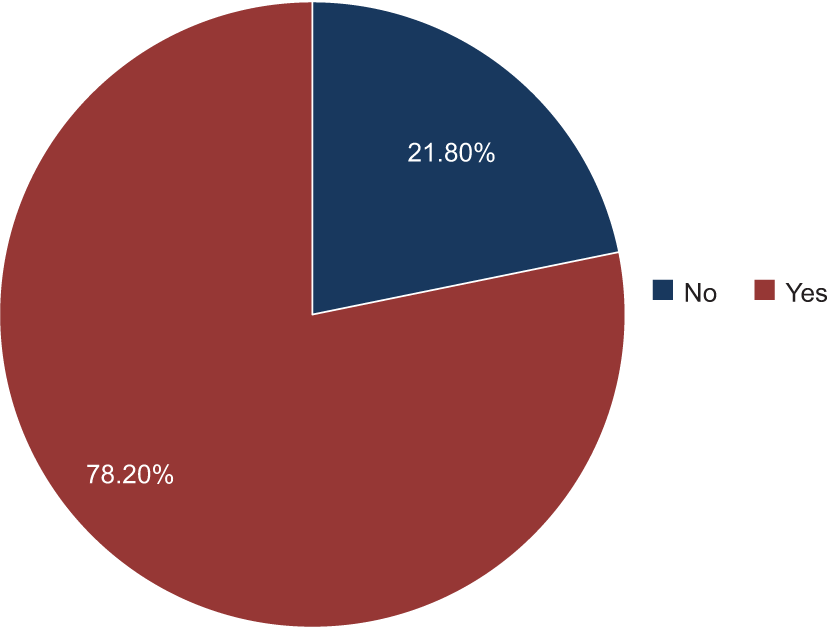
- Do you know the material used to take impression of maxillofacial defects?
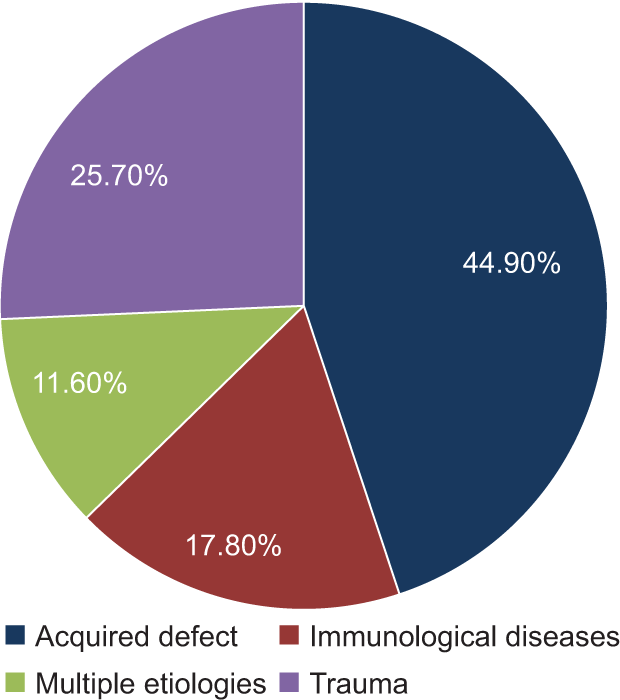
- The most common cause for maxillofacial defect?
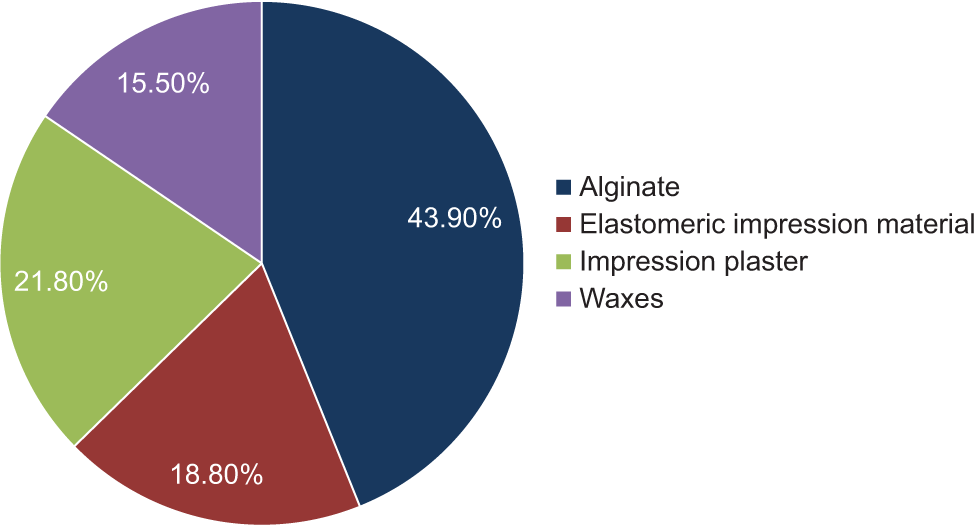
- If yes, which of the following materials are used?
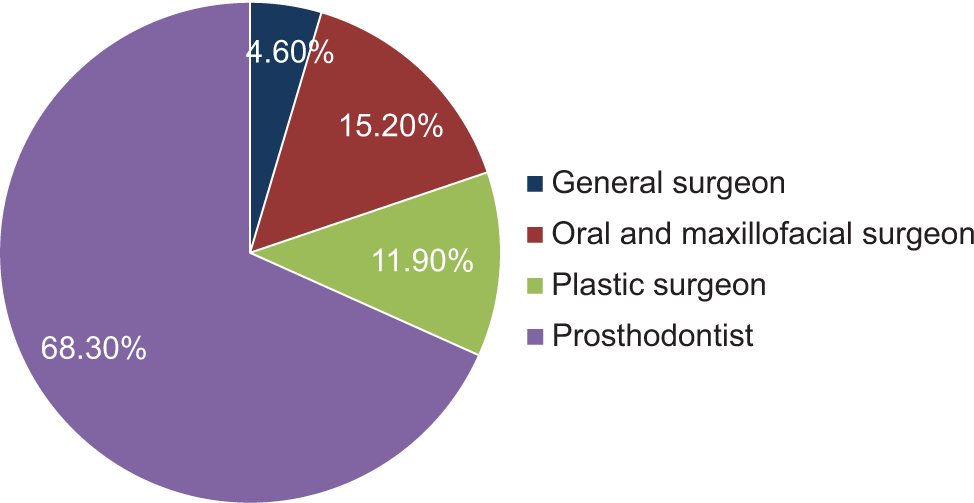
- Who would you refer for maxillofacial rehabilitation?
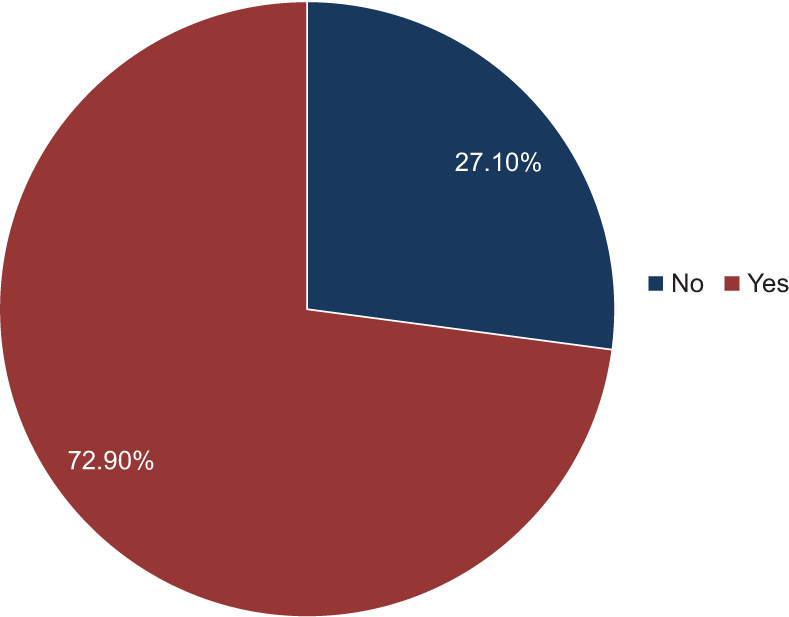
- Do you know the material used to make the maxillofacial prosthesis?
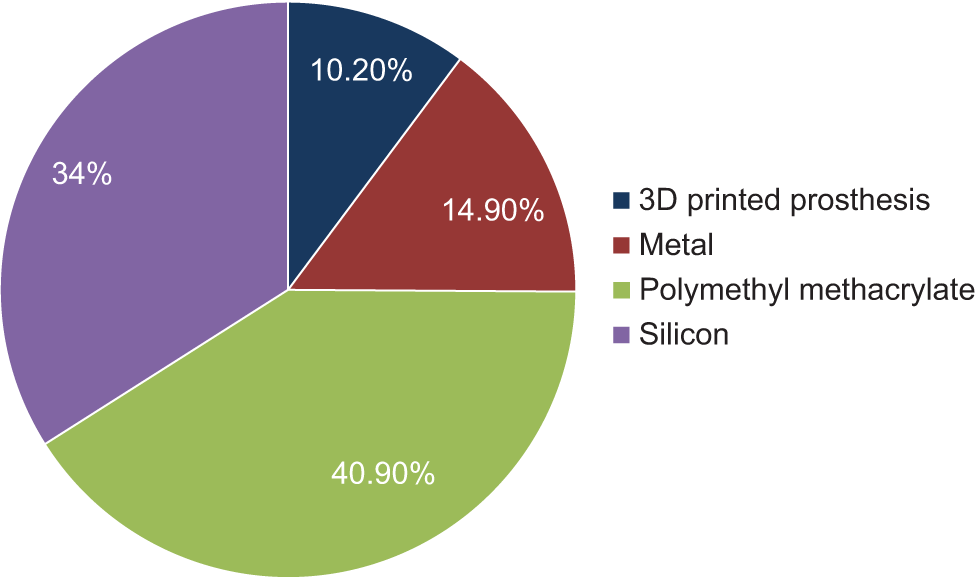
- If yes, then which of the following materials are used?
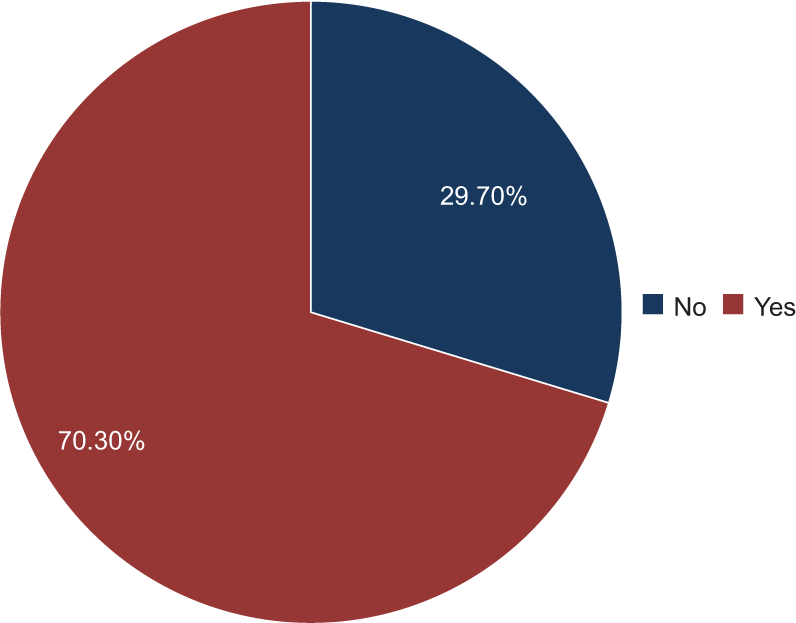
- Awareness of mean cost that patient has to face for this type of prosthesis?
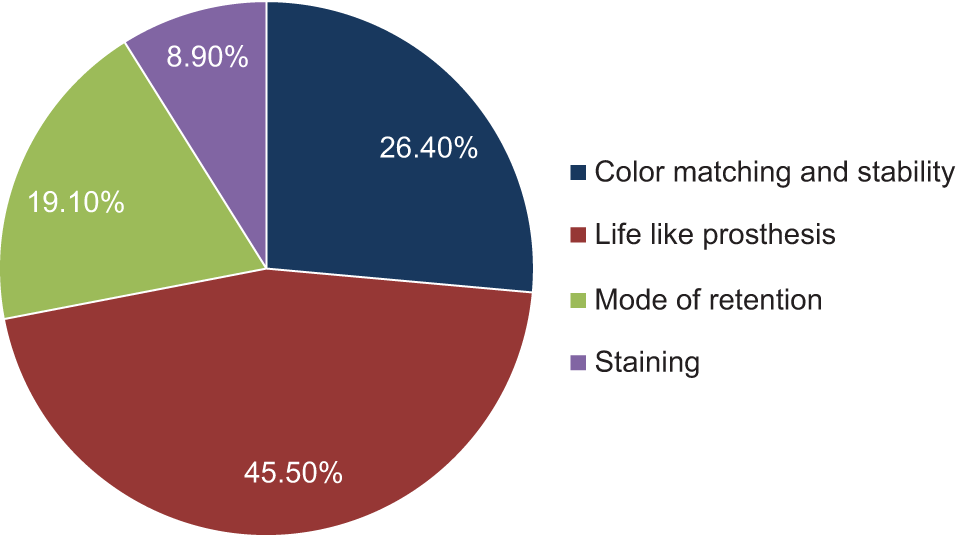
- What is the role of aesthetics in maxillofacial prosthesis?
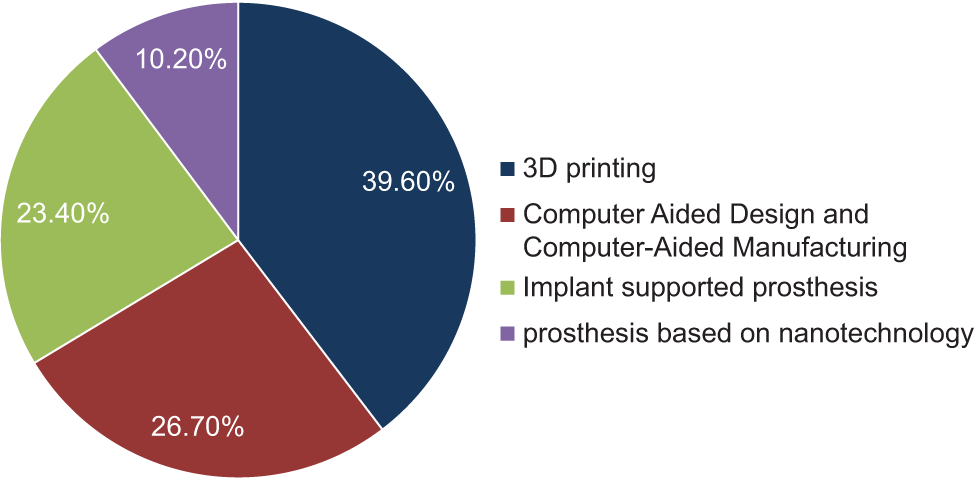
- Which recent advances in maxillofacial defect rehabilitation are you aware of?
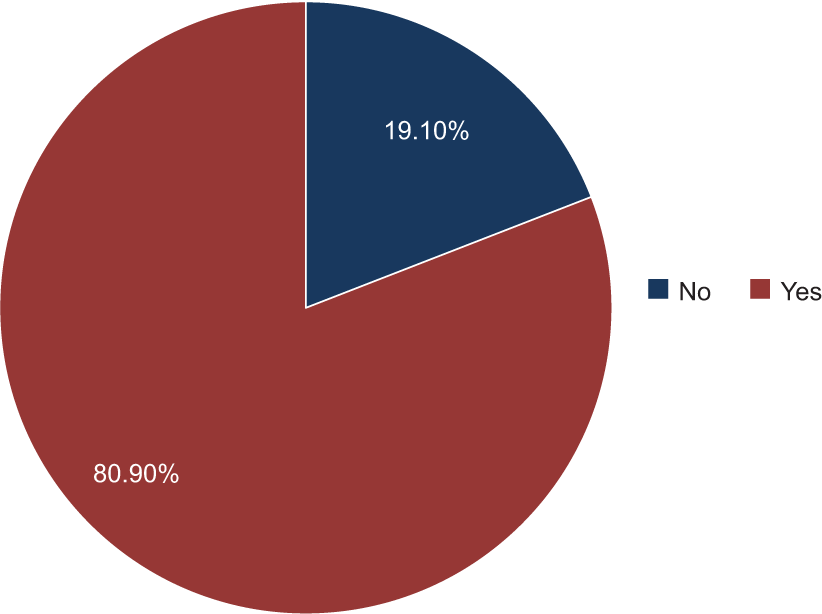
- Awareness about a fact that prosthesis better supported and retained with implants?
| Descriptive statistics | ||
|---|---|---|
| Characteristics of study population | Frequency | Percent |
| Gender | ||
| Female | 170 | 56.1 |
| Male | 133 | 43.9 |
| Total | 303 | 100.0 |
| Name of college | ||
| NKP Salve Medical College | 141 | 46.5 |
| VSPM Dental College and Research Center | 162 | 53.5 |
| Level of study | ||
| Intern | 95 | 31.4 |
| Undergraduate | 208 | 68.6 |
| Year of study | ||
| Final year | 45 | 14.9 |
| 1st year | 44 | 14.5 |
| Intern year | 91 | 30.0 |
| 2nd year | 75 | 24.8 |
| 3rd year | 48 | 15.8 |
| Descriptive statistics | ||
|---|---|---|
| Questions | Frequency | Percent |
| 1. Do you know about maxillofacial defects? | ||
| No | 44 | 14.5 |
| Yes | 259 | 85.5 |
| 2. Have you ever seen a clinical case of maxillofacial defect? | ||
| No | 79 | 26.1 |
| Yes | 224 | 73.9 |
| 3. The most common cause for maxillofacial defect? | ||
| Acquired defect | 136 | 44.9 |
| Immunological diseases | 54 | 17.8 |
| Multiple etiologies | 35 | 11.6 |
| Trauma | 78 | 25.7 |
| 4. Are you aware of various treatment modalities for maxillofacial defect rehabilitation? | ||
| No | 67 | 22.1 |
| Yes | 236 | 77.9 |
| 5. Who would you refer for maxillofacial rehabilitation? | ||
| General surgeon | 14 | 4.6 |
| Oral and maxillofacial surgeon | 46 | 15.2 |
| Plastic surgeon | 36 | 11.9 |
| Prosthodontist | 207 | 68.3 |
| 7. Which of the following types of prosthesis are you aware of? | ||
| All of the above | 238 | 78.5 |
| Ear and eye prosthesis | 24 | 7.9 |
| Ear and eye prosthesis, prosthesis for maxilla and mandible | 1 | 0.3 |
| Nasal and midfacial prosthesis | 7 | 2.3 |
| Nasal and midfacial prosthesis, ear, and eye prosthesis | 2 | 0.7 |
| Nasal and midfacial prosthesis, ear and eye prosthesis, prosthesis for maxilla and mandible, all of the above | 5 | 1.7 |
| Nasal and midfacial prosthesis, prosthesis for maxilla and mandible | 2 | 0.7 |
| Prosthesis for maxilla and mandible | 23 | 7.6 |
| Prosthesis for maxilla and mandible, all of the above | 1 | 0.3 |
| 6. Do you know different types of maxillofacial defects that require prosthesis? | ||
| Both | 225 | 74.3 |
| Do not know | 22 | 7.3 |
| Patients with acquired defect | 32 | 10.6 |
| Patients with congenital defect | 24 | 7.9 |
| 8. Do you know the material used to make the impression of maxillofacial defects? | ||
| No | 66 | 21.8 |
| Yes | 237 | 78.2 |
| 9. If yes, which of the following materials are used | ||
| Alginate | 133 | 43.9 |
| Elastomeric impression material | 57 | 18.8 |
| Impression plaster | 66 | 21.8 |
| Waxes | 47 | 15.5 |
| 10. Do you know the material used to make the maxillofacial prosthesis? | ||
| No | 82 | 27.1 |
| Yes | 221 | 72.9 |
| 11. If yes, then which of the following materials are used | ||
| 3D printed prosthesis | 31 | 10.2 |
| Metal | 45 | 14.9 |
| Polymethyl methacrylate | 124 | 40.9 |
| Silicon | 103 | 34.0 |
| 12. What is the role of esthetics in maxillofacial prosthesis? | ||
| Color matching and stability | 80 | 26.4 |
| Lifelike prosthesis | 138 | 45.5 |
| Mode of retention | 58 | 19.1 |
| Staining | 27 | 8.9 |
| 13. Are you aware of the fact that prosthesis can be better supported and retained with the help of implants? | ||
| No | 58 | 19.1 |
| Yes | 245 | 80.9 |
| 14. Are you aware of the average cost which the patient will have to bear for such kind of prosthesis? | ||
| No | 90 | 29.7 |
| Yes | 213 | 70.3 |
| 15. Which recent advances in maxillofacial defect rehabilitation are you aware of? | ||
| 3D printing | 120 | 39.6 |
| CAD-CAM | 81 | 26.7 |
| Implant-supported prosthesis | 71 | 23.4 |
| prosthesis based on nanotechnology | 31 | 10.2 |
CAD: Computer-aided design, CAM: Computer-aided manufacturing
The students who had a certain amount of knowledge regarding maxillofacial defects and their rehabilitation were observed to have awareness about types of maxillofacial defects and were aware of referring patients with maxillofacial defects for rehabilitation to a prosthodontist. It was also found that awareness regarding maxillofacial prosthesis was there, specifically about ear and eye prosthesis as compared to others. In terms of material knowledge, most of the undergraduates were aware that the material of choice for taking the impression of the prosthesis is alginate. Many of the undergraduates are aware that prosthesis can be better supported and retained with the help of implants. The undergraduates were apprised about the mean charges that a patient has to face such type of prosthesis. Maximum undergraduates are aware of 3D printing in recent advances. Although most students were aware of maxillofacial defects and its treatment protocols, it was observed that the undergraduate students of VSPM Dental College were more informed about it than the students of NKP Salve Institute of Medical Sciences, which indicated a need for creating awareness in all medical institutes.
It was also found that most of the undergraduates lacked awareness about the common cause of maxillofacial defects and were also not aware of the treatment modalities for maxillofacial defects. It was also observed that they did not have knowledge regarding the role of esthetics in maxillofacial prosthesis.
DISCUSSION
Patients with maxillofacial defect problems might benefit from extended appliances such as finger prostheses, vaginal stents, and other things thanks to maxillofacial prosthodontics, which aims to restore form and function. Maxillofacial prosthodontists collaborate with other specialists on interdisciplinary teams.
They collaborate closely with speech therapists, occupational therapists, and physiotherapists, as well as oral surgeons, cosmetic surgeons, ear, nose, and throat surgeons, eye specialists, general surgeons, cancer specialists, orthopedic surgeons, obstetricians, and pediatrists.
Few people in the general public and among medical professionals are aware of the capabilities and range of a maxillofacial prosthodontist. The practitioners have some knowledge of such a method of therapy and that it is under the prosthodontist’s scope of study. Due to ignorance, patients with maxillofacial abnormalities are improperly advised and directed to a maxillofacial prosthodontist for rehabilitation. The dentofacial and craniofacial area plays an important part in looks because it shows an individual’s identity. Every change, even small, makes a drastic change in the outside appearance, and it harms the patient’s mental health.[9]
While craniofacial and dentofacial defects are classified into two types, that is, congenital and acquired malformations. The cause exists the same, and it is the duty of the treating dentist to identify the cause and develop an effective treatment plan.[10]
In this study, a population of 136 undergraduates out of 300 undergraduates (44.9%) chose acquired defects as the most common cause of maxillofacial defects. While in the study conducted by Aksoy et al. is the opposite, stating that trauma is the most common cause of maxillofacial defects.[11]
In this study, it was discovered that undergraduate students had a high knowledge of maxillofacial deformities because the maximum number of students were aware of these limitations have numerous causes and need for an integrative way. It was consistent with research done by Alani et al. on maxillofacial surgeons’ attitudes toward the treatment and rehabilitation of oral cancer patients.[12]
In this study, the majority of students were aware of prosthodontists’ role in the rehabilitation of craniofacial abnormalities. However, in this study, undergraduates have more awareness compared to research done by Vadepally et al., Only 3% of physicians were found to choose oral and maxillofacial surgery when referring cases of cleft lip and palate and related craniofacial syndromes.[13]
In this study, among respondents, 45.5% said that the most crucial element of esthetic rehabilitation is a lifelike prosthesis. This study was not that much in correlation with research done by Hatamleh et al., where 95.4% of the patients were satisfied with all satisfaction statements presented, proving that their prosthesis was comfortable to wear, looked realistic, and met their belief (i.e., facial look), thus boosting their confidence.[14]
In this study, the majority of the students in this study were not aware of the most recent treatment planning techniques for the rehabilitation of craniofacial abnormalities. Contrary research revealed this to a similar research done by Sharma et al., on U.G. dental students of Nepal regarding dental implants, where most of the respondents agreed that they were not provided with sufficient information about implant procedures during their U.G. program.[15]
CONCLUSION
Undergraduates have an understanding, point of view, and awareness regarding dentofacial and craniofacial defects and its rehabilitation. The most recent advances must be delivered, and students must have enough information to advise and direct a patient.
Ethical approval
The research/study approved by the Institutional Review Board at VSPM Dental College, number IEC/VSPMDCRC/110/2022, dated 12th December 2022.
Declaration of patient consent
Patient consent not required as there no patients in this study.
Conflicts of interest
There are no conflicts of interest.
Use of artificial intelligence (AI)-assisted technology for manuscript preparation
The authors confirm that there was no use of artificial intelligence (AI)-assisted technology for assisting in the writing or editing of the manuscript and no images were manipulated using AI.
Financial support and sponsorship: Nil.
References
- Maxillofacial prosthetic rehabilitation: A survey on the quality of life. J Prosthet Dent. 2018;120:780-6.
- [CrossRef] [PubMed] [Google Scholar]
- Maxillo facial rehabilitation: Prosthodontic and surgical consideration (2nd ed). St Louis: Ishiyaku Euro America; 1996. p. :240-85.
- [Google Scholar]
- Body image and disfigurement: Issues and interventions. Body Image. 2004;1:83-97.
- [CrossRef] [PubMed] [Google Scholar]
- Dento-alveolar and maxillofacial injures-a survey of knowledge of the regimental aid providers in the Israeli army. Dent Traumatol. 2007;23:243-46.
- [CrossRef] [PubMed] [Google Scholar]
- Maxillofacial trauma. 2004. Available from: https://www.healthofchildren/com/m/maxillofacial-trauma.html [Last accessed on 2023 Nov 10]
- [Google Scholar]
- Perception of oral maxillofacial surgery by health-care professionals. Int J Oral Maxillofac Surg. 2008;37:41-6.
- [CrossRef] [PubMed] [Google Scholar]
- Awareness of the specialty of oral and maxillofacial surgery among health care professionals in Pondicherry, India. J Oral Maxillofac Surg. 2008;66:2330-34.
- [CrossRef] [PubMed] [Google Scholar]
- Dentistry in the 21st Century: A look into the future. J Oral Health Community Dent. 2009;3:9-14.
- [CrossRef] [Google Scholar]
- Quality of life and facial trauma: Psychological and body image effects. Ann Plast Surg. 2005;54:502-10.
- [CrossRef] [PubMed] [Google Scholar]
- Maxillofacial defects and their classification: A review. Int J Adv Res. 2016;4:109-14.
- [CrossRef] [Google Scholar]
- A retrospective study on epidemiology and treatment of maxillofacial fractures. J Craniofac Surg. 2002;13:772-5.
- [CrossRef] [PubMed] [Google Scholar]
- A national survey of oral and maxillofacial surgeons' attitudes towards the treatment and dental rehabilitation of oral cancer patients. Br Dent J. 2009;207:E21. discussion 540-1
- [CrossRef] [Google Scholar]
- Oral and maxillofacial surgery: Perception of its scope among the medical fraternity and general public. J Cranio Maxillary Dis. 2015;4:21-7.
- [CrossRef] [Google Scholar]
- Survey of ocular prosthetics rehabilitation in the United Kingdom, part 2: Anophthalmic patients' satisfaction and acceptance. J Craniofac Surg. 2017;28:1297-301.
- [CrossRef] [PubMed] [Google Scholar]
- Preferred source and perceived need of more information about dental implants by the undergraduate dental students of Nepal: All Nepal survey. Int J Dent. 2018;2018:6794682.
- [CrossRef] [PubMed] [Google Scholar]
